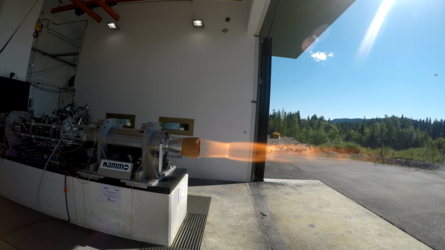Norway takes the lead in hybrid propulsion
Today, Norway’s first hybrid rocket to reach space demonstrated new hybrid propulsion technology for a cleaner, safer, more flexible method of powering small launch vehicles.
Soaring up to five times the speed of sound from the Andøya Space Center, the 9 m long Nucleus sounding rocket passed the edge of Earth’s atmosphere to reach an altitude of over 107 km in less than three minutes.
After its suborbital flight it returned to Earth, splashing down in the Atlantic Ocean, 180 km off the coast of Norway. Its payload, supplied by the Andøya Space Center, comprised electronics that transmitted inflight data and video for further analysis, as well as a dispenser to eject six ‘daughter payloads’ at altitude.
Nammo in partnership with ESA’s Future Launchers Preparatory Programme designed and built the new hybrid motor driving this rocket. The motor combines liquid and solid propellant.
Nammo chose highly concentrated liquid hydrogen peroxide as the oxidiser reacting with a rubber-like substance as fuel. These substances are safe to handle and the byproducts of combustion are mostly water and carbon dioxide – making the motor environmentally friendly too.

The oxidiser and solid fuel remain separated inside the rocket until mixed at ignition. Hybrid propellants have low evaporation rates so the rocket can be loaded safely, well before launch. This reduces the cost of launch service operations compared with other technologies.
The fuel being a non-toxic, non-explosive solid simplifies manufacturing and handling, further lowering cost.
Being able to vary the flow of oxidiser during flight and thus the thrust meets a wide range of mission requirements, the motor can even be shut down and reignited for complex missions.
The aim is for hybrid propulsion to match the precision offered through liquid propulsion, while lowering risks and costs, which would be ideal for smaller European launch sites like the Andøya Space Center.
Today’s demonstration will provide valuable data on the behaviour of this hybrid propulsion system in flight. The next step is to build a larger motor to increase thrust from today’s 30kN to about 75–100 kN, extend the burn time, and to reduce weight and cost.
"Hybrid technology has the potential to become a highly competitive building block for an orbital launcher – our ultimate goal,” commented Adrien Boiron, Chief engineer at Nammo.















 Germany
Germany
 Austria
Austria
 Belgium
Belgium
 Denmark
Denmark
 Spain
Spain
 Estonia
Estonia
 Finland
Finland
 France
France
 Greece
Greece
 Hungary
Hungary
 Ireland
Ireland
 Italy
Italy
 Luxembourg
Luxembourg
 Norway
Norway
 The Netherlands
The Netherlands
 Poland
Poland
 Portugal
Portugal
 Czechia
Czechia
 Romania
Romania
 United Kingdom
United Kingdom
 Slovenia
Slovenia
 Sweden
Sweden
 Switzerland
Switzerland





























